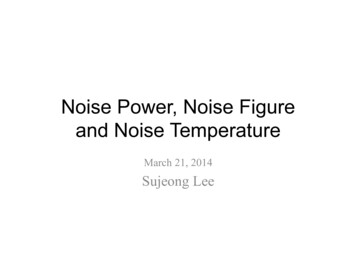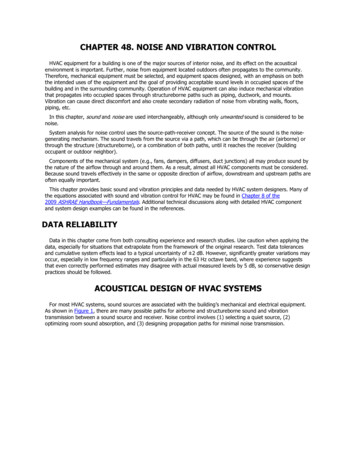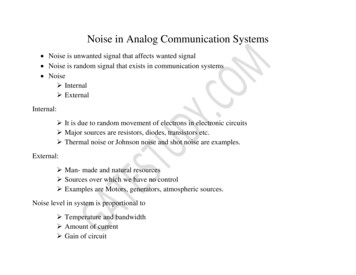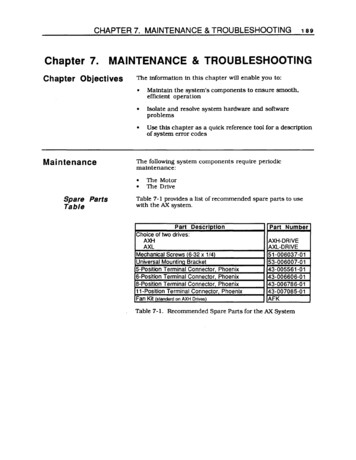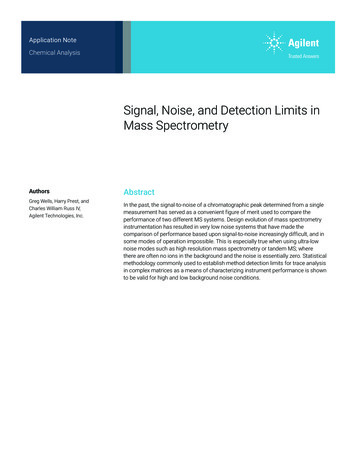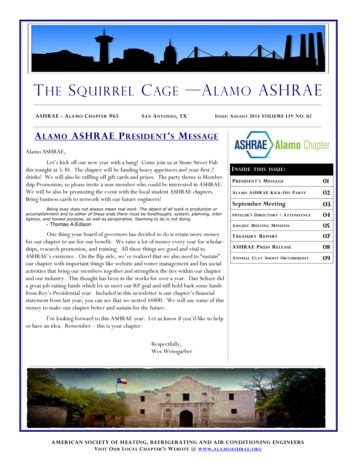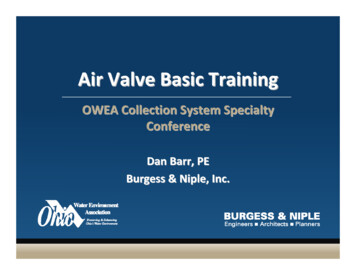
Transcription
SECTION 2Air, Noise, and Light PollutionAir pollution can cause serious health problems. People who arevery young or very old and people who have heart or lung problems can be most affected by air pollutants. Decades of researchhave shown convincing evidence linking air pollution to disease.But because pollution adds to the effects of existing diseases, nodeath certificates list the cause of death as air pollution. Instead,diseases such as emphysema, heart disease, and lung cancer arecited as causes of death. The American Lung Association has estimated that Americans pay tens of billions of dollars a year inhealth costs to treat respiratory diseases caused by air pollution.Short-Term Effects of Air Pollution on HealthMany of the effects of air pollution on people’s health are shortterm and are reversible if their exposure to air pollution decreases.The short-term effects of air pollution on people’s health includeheadache; nausea; irritation to the eyes, nose, and throat; tightnessin the chest; coughing; and upper respiratory infections, such asbronchitis and pneumonia. Pollution can also make the conditionof individuals who suffer from asthma and emphysema worse.Objectives왘 Describe three possible short-termeffects and long-term effects of airpollution on human health.왘 Explain what causes indoor air pollution and how it can be prevented.왘 Describe three human health problems caused by noise pollution.왘 Describe solutions to energy wastecaused by light pollution.Key Termssick-building syndromeasbestosdecibel (dB)Long-Term Health Effects of Air PollutionLong-term effects on health that have been linked to air pollutioninclude emphysema, lung cancer, and heart disease. Long-termexposure to air pollution may worsen medical conditions sufferedby older people and may damage the lungs of children.www.scilinks.orgTopic: RespiratoryDisordersSciLinks code: HE4094Figure 8 왘 This police officer wearsa smog mask as he directs traffic inBangkok, Thailand.Copyright by Holt, Rinehart and Winston. All rights reserved.Section 2 Air, Noise, and Light Pollution 309
Connection toChemistryFormaldehyde Formaldehyde isa colorless gas that has a strongodor. It is a very common industrial and commercial chemicalthat is used to make buildingmaterials and household products. In the home, significantamounts of formaldehyde arefound in adhesives in plywood,particle board, furniture, and carpet. Other sources of formaldehyde may be foam insulation, gasstoves, tobacco smoke, and drycleaned clothing. The healtheffects of formaldehyde mayinclude eye irritation, burningsensations in the throat, nausea,and difficulty breathing.Indoor Air PollutionThe quality of air inside a home or a building is sometimes worsethan the quality of the air outside. Plastics and other industrialchemicals are major sources of pollution. These compounds canbe found in carpets, building materials, paints, and furniture, particularly when these items are new. Figure 9 shows examples ofsome indoor air pollutants.Buildings that have very poor air quality have a conditioncalled sick-building syndrome. Sick-building syndrome is mostcommon in hot places where buildings are tightly sealed to keepout the heat. In Florida, for example, a new, tightly sealed countycourthouse had to be abandoned. Half of the people who workedthere developed allergic reactions to fungi that were growing inthe air-conditioning ducts, ceiling tiles, carpets, and furniture.Identifying and removing the sources of indoor air pollutionis the most effective way to maintain good indoor air quality.Ventilation, or mixing outdoor air with indoor air, is also necessary for good air quality. When activities such as renovation andpainting, which cause indoor air pollution, are undertaken, ventilation should be increased.The Health Effects of Ground-Level OzoneYou have learned that the ozonelayer in the stratosphere shields theEarth from the harmful effects ofultraviolet radiation from the sun.At the surface of the Earth, however, ozone is a human-made airpollutant that at certain concentrations may affect human health.Ozone forms from the reaction ofvolatile organic compounds (VOCs)and nitrogen oxides (NOx) in thepresence of heat and sunlight. Highconcentrations of ozone form in theatmosphere on sunny days that havehigh temperatures in the late spring,summer, and early fall. The sources ofVOCs and NOx emissions are largelymotor vehicles, power plants, gasoline vapors, and chemical solvents.Most ozone pollution forms in urban310 Chapter 12 Air왘 Children who engage in vigorousoutdoor activities where pollutantconcentrations are often high mayhave a greater risk of developingasthma or other respiratory illnesses.and suburban areas. However, pollutants may be transported hundredsof kilometers from their source.As ozone concentrations in theatmosphere increase, greater numbers of people may experienceharmful health effects of ozone onthe lungs. Some of the short-termeffects of ozone on health includeirritation of the respiratory system,a reduction in lung function, theaggravation of asthma, and inflammation to the lining of the lungs.Scientists believe that ozone mayhave other damaging effects onhuman health. Lung diseases suchas bronchitis and emphysema maybe aggravated by ozone. ScientistsCopyright by Holt, Rinehart and Winston. All rights reserved.
Figure 9 왘 Someindoor air pollutantsand their sources areshown here.Those who are most at riskfrom ozone include children, adultswho exercise or work outdoors,older people, and people who sufferfrom respiratory diseases. In addition, there are some healthy individuals who have unusually highsusceptibility to ozone.CRITICAL THINKING1. Making Decisions Write a briefparagraph explaining whether ornot lung-function tests should bemandatory for children who live inurban areas where high concentrations of ozone are frequent.왘 A therapist performs a lung-function test on a patient by usingWRITING SKILLSa machine that measures various aspects of lung function.believe that permanent lung injurymay result from repeated shortterm exposure to ozone pollution.Children who are regularly exposedto high concentrations of ozonemay have reduced lung function asadults. Exposure to ozone may alsoaccelerate the natural decline inlung function that is part of theaging process.Copyright by Holt, Rinehart and Winston. All rights reserved.2. Making Decisions If lungfunction tests become mandatory,who will pay for these tests, and whowill provide the equipment? Wouldthese tests be performed at school,in a doctor’s office, or at a hospital?Section 2 Air, Noise, and Light Pollution 311
Radon Gas Radon gas is colorless, tasteless, and odorless. It isalso radioactive. Radon is one of the elements produced by thedecay of uranium, a radioactive element that occurs naturally inthe Earth’s crust. Radon can seep through cracks and holes infoundations into homes, offices, and schools, where it adheres todust particles. When people inhale the dust, radon enters theirlungs. In the lungs, radon can destroy the genetic material in cellsthat line the air passages. Such damage can lead to cancer, especially among people who smoke. Radon is the second-leadingcause of lung cancer in the United States.Figure 10 왘Asbestos (right) formsin long, thin fibers. Theworker above is removingdebris from a structure that wasbuilt with asbestos.Asbestos Several minerals that form in long, thin fibers andthat are valued for their strength and resistance to heat arecalled asbestos. Asbestos is primarily used as an insulator and as a fire retardant, and it was used extensively in building materials. The U.S.government banned the use of most asbestosproducts in the early 1970s. Exposure toasbestos in the air is dangerous. Asbestosfibers that are inhaled can cut and scar thelungs, which causes the disease asbestosis.Victims of the disease have more and moredifficulty breathing and may eventually dieof heart failure. Schools in the United Stateshave taken this threat seriously. Billions of dollars have been spent to remove asbestos from schoolbuildings. Figure 10 shows asbestos fibers and asbestosremoval from a building.Table 2 왔Noise PollutionIntensity ofCommon NoisesNoiseIntensity (dB)Rocket engine180Jet engine140Rock-and-rollconcert120Car n60Whisper30Faintest soundheard by thehuman ear312 Chapter 12 Air0A sound of any kind is called a noise. However, some noises areunnecessary and can cause noise pollution. Noise is a pollutantthat affects human health and the quality of human life.Airplanes, construction equipment, city traffic, factories, homeappliances, and lawnmowers are some of the examples of thingsthat make unnecessary sounds that commonly travel through theair. Health problems that can be caused by noise pollution includeloss of hearing, high blood pressure, and stress. Noise can alsocause loss of sleep, which may lead to decreased productivity atwork and in the classroom.The intensity of sound is measured in units called decibels (dB).The lowest point on the decibel scale is 0 dB and the highest pointis 180 dB. For each increase in decibel intensity, the decibel level is10 times higher than the previous level. For example, 20 dB is 10times the intensity of 10 dB, 30 dB is 100 times the intensity of 10dB, and 40 dB is 1,000 times the intensity of 10 dB. Table 2 showsthe intensity of some common sounds. A sound of 120 dB is at thethreshold of pain. Permanent deafness may come as a result of continuous exposure to sounds over 120 dB.Copyright by Holt, Rinehart and Winston. All rights reserved.
Figure 11 왘 This view of SeattleLight PollutionUnlike air or water pollution, light pollution does not present adirect hazard to human health. However, light pollution does negatively affect our environment. The use of inefficient lighting inurban areas is diminishing our view of the night sky. In urban areas,the sky is often much brighter than the natural sky.A more important environmental concern of inefficient lighting is energy waste. For example, energy is wasted when light isdirected upward into the night sky and lost to space, as shown inFigure 11. Examples of inefficient lighting are billboards andother signs that are lit from below, the lighting of building exteriors, and poor-quality street lights. One solution to energy wasteincludes shielding light so it is directed downward. Using timecontrols so that light is used only when needed and using lowpressure sodium sources—the most energy-efficient source oflight—wherever possible are two other solutions.SECTION 2shows how lighting in urban areascan cause skyglow, which is an effectof light that can dramatically reduceour view of the night sky.FIELD ACTIVITYLight Pollution At night, inyour neighborhood or from yourfront porch, note any efficient orinefficient uses of light that yousee, and write down your observations in your EcoLog.Review1. Describe the long-term effects and the short-termeffects of air pollution on health.2. Describe two ways in which indoor air pollution canbe prevented.3. Describe some of the human health problemscaused by noise pollution.4. Describe several solutions to the energy waste associated with light pollution.Copyright by Holt, Rinehart and Winston. All rights reserved.CRITICAL THINKING5. Making Comparisons Read the descriptions ofnoise and light pollution in this section. Explain waysin which noise pollution and light pollution are similarand ways they are different. READING SKILLS6. Analyzing Relationships Molds can grow in new,tightly sealed buildings where the humidity is high andthe ventilation is poor. Explain how you would controlthe growth of mold in this type of environment.Section 2 Air, Noise, and Light Pollution 313
includes shielding light so it is directed downward. Using time controls so that light is used only when needed and using low-pressure sodium sources—the most energy-efficient source of light—wherever possible are two other solutions. Section 2 Air, Noise, and Light Pollution313 1. Describe the long-term effects and the short-term
